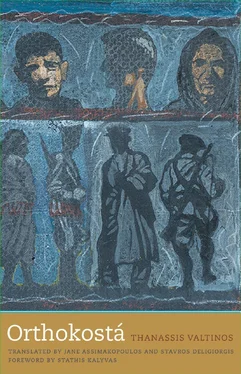Indeed, the thorny issue of collaboration stands at the core of Orthokostá . During the first two years of the Occupation, active collaboration with Axis forces was marginal, limited mainly to fascist ideologues, members of previously repressed ethnic minorities, and opportunists of various kinds. This began to change in 1943. The capitulation of Italy, the rapid spread of the Resistance, and the ineffectiveness of a counterinsurgency based on blind, indiscriminate reprisals convinced the occupiers that they were in urgent need of local assistance. It was at this point that a widespread loathing of the Communists and their methods came together with the Germans’ need for local allies, causing the explosive growth of a new kind of grassroots armed collaboration that reached unprecedented levels, comparable to the reach of ELAS.
This process was fed by a gradual escalation of violence. The destruction of nationalist guerrilla bands and the ensuing repression by the Communists encouraged a grassroots opposition to EAM and ELAS that remained silent so long as it was unarmed. However, when the Germans began to supply the dissidents with weapons in the spring and summer of 1944, this opposition became both vocal and violent. Now areas that had been ruled by EAM came under the control of the occupiers and their collaborators. But this period was brief; almost immediately the Germans began retreating in anticipation of their departure from Greece. It was then that ELAS returned with a vengeance and destroyed the villages that had been disloyal to it such as Kastri.
Nor did this cycle of violence stop with the end of the Occupation. The Communist insurrection in Athens in December 1944 provided the stage for new atrocities, followed by low-intensity warfare in 1945–46, which was accompanied by the persecution, formal and informal, of real and suspected Communists. The Civil War moved into its final phase, often referred to as “the” Greek Civil War, in 1946. Now, however, the main theater of armed action was northern Greece, which explains why this conflict does not appear very much in Orthokostá .
When examining the grassroots collaboration, we cannot help but wonder about individual motives. Why would so many people ally with the Germans, who were at best disliked and at worse hated? Some of the narrators provide straightforward answers:
The Battalions weren’t formed in Trípolis only. They were in all the towns of the Peloponnese. Those were times of national emergency. No Greek ever liked the Germans. Or wanted to collaborate with them. That’s when the Peloponnese Battalions were created. In the spring of 1944. When it was becoming clear that the Germans were losing the war. And it was also becoming clear how dangerous it would be for anyone who might find himself at the mercy of ELAS after the German collapse. After they cleared out. . EAM and ELAS were the imminent danger. They would wipe us all out. Any of us who didn’t want to or wouldn’t consent to join them. That’s how we saw it — and that’s how it was.
The Battalions were formed later on. As a reaction to everything that had happened. To the arrests and the executions.
Of course these answers only scratch the surface of a complex issue. It is fascinating to explore the multiple drivers of what appear to be straightforward political choices but in reality are multifaceted processes that include everything from personal disputes and local vendettas to concerns about survival and safety by a population caught between two fires:
Take the village of Oriá. They hated anyone from Karátoula, so much hatred between those two villages.
So I went and enlisted. I owed that time. But that’s what always happens. Where will you get food, where will you sleep? In the barracks. Wherever they give you food. That was the beginning of the enlistments. On both sides. That was one reason to enlist. And the other was safety. In the mountains no one came after you. You went around, you ate, you drank, you got laid. Otherwise you were a reactionary, and you were hounded. You ended up in the Battalions. You found a place to lay your head.
The rebels came here, they said, Leave your houses, all of you. Whoever stays in the village will be executed. And the Germans dropped leaflets. Stay in your homes, no one will harm you.
This was a world dominated by violence, which was both a cause of individual choices and behaviors but also their inevitable consequence, taking endless shapes and forms because “a human life wasn’t worth much then, that’s how things were.” Or as another narrator puts it simply: “Ruthless men.”
Violence could be indiscriminate, but more often it was highly personal. Indeed, this was a highly personalized war, which only made it that much more terrifying. We cannot help but shudder at statements like “It was our cousin Paraskevás who marched our brother Kóstas up along the river” or “An exceptional man, a progressive farmer, among the best in the area. And that splendid young man was taken to the detention camp by his own brothers. Who executed him later on.”
As is often the case, the mechanism that reproduced and escalated violence was revenge, a central feature of many narratives and a powerful driver of violent behavior in general: “We were young then. We wanted revenge.” When it comes to revenge, the narratives that stand out include the terrible first-person description of the ordeal imposed on a rival (“With my brother killed and everything, just like I told you. I was fourteen, fifteen. And that’s why I took care of Pavlákos later on. I beat him for one whole day and one night.”), or the third-person description of the beating of a Communist by the husband of the pregnant woman he had allegedly condemned to death (“I wish I hadn’t seen all that”). It is also striking how revenge transcends geography: escaping to Athens offered no respite, as revenge-seekers followed their enemies and took advantage of the chaotic situation to target and assassinate them. Inevitably, revenge caused counter-revenge, violence led to more violence. Even after the violence stopped, the memory of it shaped people’s identities and affected their behavior in lasting ways.
Not everything in the novel is bleak, however. There is a flip side to the revenge narratives, for instance, consisting of accounts of positive reciprocity when people who protected others by erasing a few names from a target list, intervening on someone’s behalf, or refusing to denounce someone who victimized them were later protected in a moment of need by those they had helped. The story of Yiórgos and Yeorghía in chapter 2 is particularly moving in this respect.
The violence also has its absurd side. We find it in the story of the young woman who stitched a crown instead of a hammer and sickle on the berets she made for the Communist guerrillas and almost lost her life because of it, the man who was executed by the Germans when they found that the papers he had stuffed into his shoes to blunt the nails holding the soles were EAM leaflets, or the Security Battalion officer who survived many difficult moments only to be assassinated in Athens where he went to pursue his love interest. The pinnacle of absurdity is probably reached when German troops turn out as the liberators of the peasants being held by the guerrillas in the monastery detention camp.
Of course, taking all these complex processes into account does not mean that we need to accept that the choices made by these individuals are morally justified. It is worth stressing here that Orthokostá is by no means one-sided. We find in it extensive descriptions of atrocities committed by the Security Battalions (see, for example, chapters 6 and 33), while several narrators provide many qualifications and counterpoints. However, critics who accuse Valtinos of equating understanding with excusing miss the book’s point, which is to reveal the intricate universe into which all these people moved and to immerse us in it. On that score, Orthokostá is an unmitigated success.
Читать дальше


